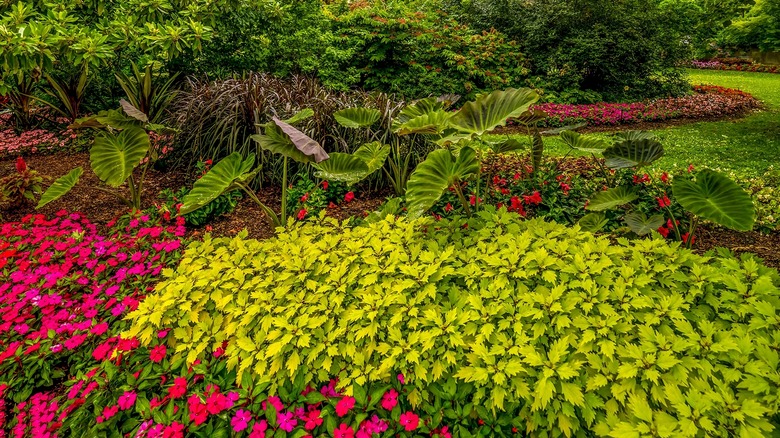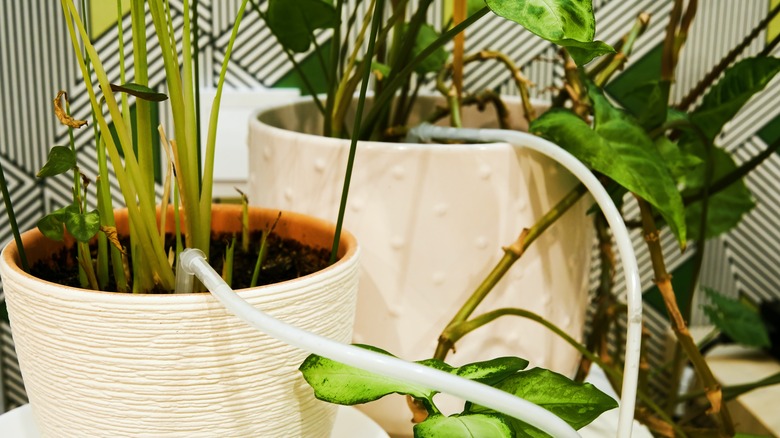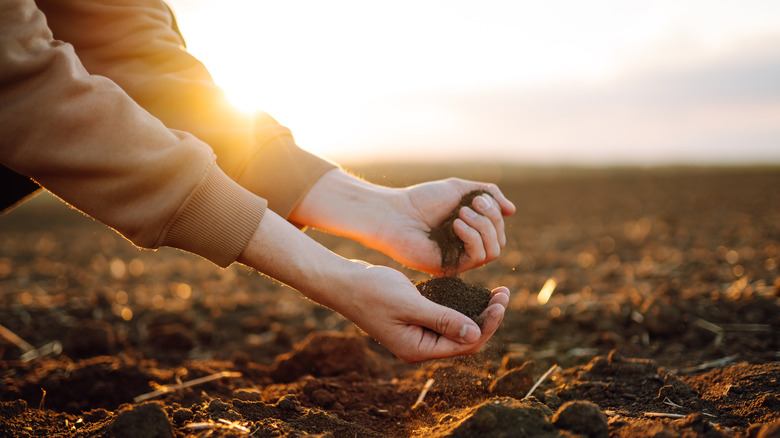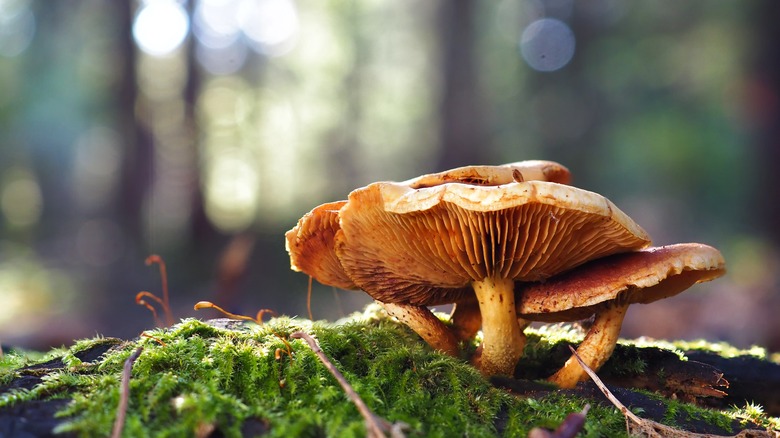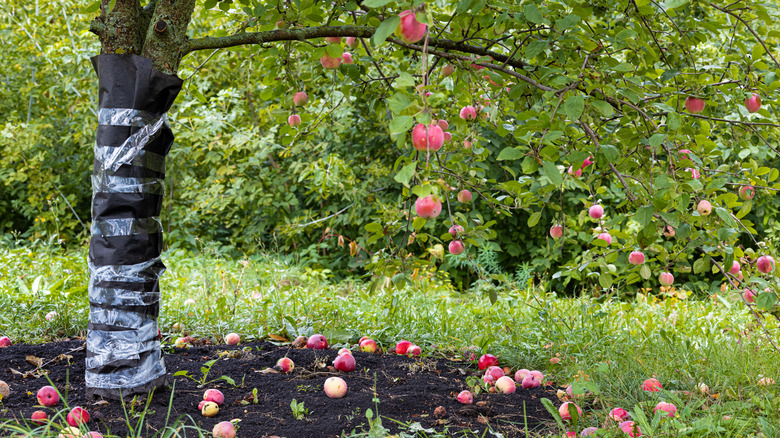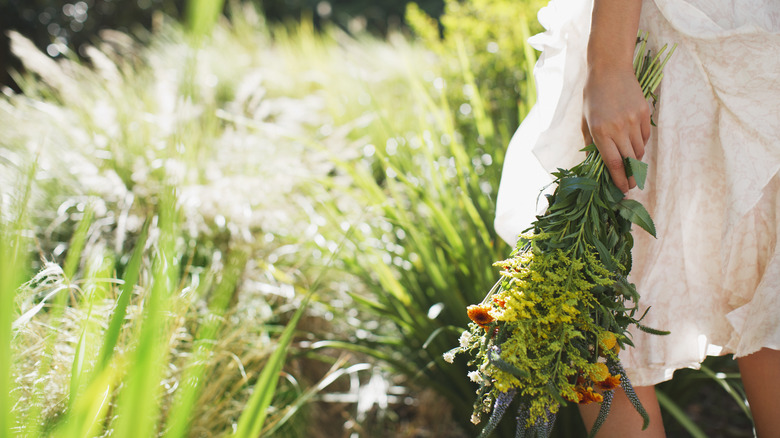How To Create A Climate-Resilient Garden, According To An Expert
Homeowners who want to incorporate more environmentally sustainable practices and priorities might want to consider a climate-resilient garden. Resiliency in the garden isn't a new feature, but it has received increasing attention in the last few years. Honestly Modern notes that climate resilient gardens are sometimes referred to as climate victory gardens and can play an integral role in reducing carbon in the atmosphere, boosting soil health, and promoting increased nutrition in the crops produced.
In an exclusive interview with House Digest, Mandalin Sattler, the Director of Permaculture Systems, and Eloisa Lewis, the Founder and Lead Design Consultant of New Climate Culture discuss the benefits and what is required to establish a climate-resilient garden. "Creating a climate resilient garden takes thoughtfulness, observation, and most of all, experimentation," they explain. "Each garden space is different and requires a different way of managing your plants depending on your bio-region and climate." This means that the establishment of your own garden will be unique and personal. As you develop your garden, they "recommend talking with your local community for advice, and tracking your garden experiments along the way to see what works best for you throughout the seasons and years."
Use sustainable watering practices
Watering practices are critical, regardless of the garden you are seeking to cultivate. "The most important thing to consider in a garden is water. Water is life, and we need water to keep our gardens thriving," said Sattler and Lewis. Sadly, many people simply turn on the sprinklers or run an irrigation hookup through their growing space that connects to a faucet without thinking of the larger impact. "A good first start when designing a garden is to set up on-site rainwater harvesting. Consider what surfaces are available for water collection. A nearby house, shed, or greenhouse are great options for affixing gutters and rain barrels," they explain.
Alternatively, they suggest that "if you are gardening on a slope, a low-tech alternative to rain barrels is using berms and swales. These use simple ditches and hills dug into the contour of your slope to slow and collect rainwater." Utilizing rainwater can drastically minimize your dependence on your home's water supply for growth. Moreover, limiting your water usage can reduce your monthly utility bills, and can go a long way to helping the environment around you. In many parts of the country, rainfall is abundant enough to completely shift away from piped water use, making your irrigation system completely self-sustaining with a large enough collection apparatus.
Implement Korean natural farming
Soil is another essential ingredient for a thriving garden. If you aren't planting in healthy and fertile soil, you are starting off on the back foot with your climate-resilient garden. Soil health is all about core fundamentals, and while there are a plethora of chemical treatments out there that you can use to enhance your soil in the short term, they require non-sustainable practices and won't develop the same richness and resiliency that you are seeking.
"An interesting method for supporting plants' needs for growth and development is a practice called Korean natural farming (KNF). KNF is an organic agricultural technique that takes advantage of indigenous microorganisms like bacteria, fungi, nematodes, and protozoa to produce fertile soil that yields high output without the use of herbicides or pesticides," Sattler and Lewis said. "We want to think about the soil as an organism that is alive and well. KNF uses methods that involve things like compost tea application, organic nutrient fermentation, foliar feeding, and other methods that support the biodiversity within our soil's food web," they continue.
Bring in fungi
The kinds of plants you incorporate are crucial to a thriving planting medium, as well. Ensuring that your soil is rich and full of thriving life can provide for more sustainability and improved crop performance. Sattler and Lewis note that fungi can help support this goal. "Fungi play a vital role in our soil's vitality. Fungi is composed of what most people know as mushrooms, the above-ground fruiting bodies, and mycelium, the underground network of root-like fibers."
Fungi enjoy a symbiotic relationship with other plant life. "Mycelium helps break down compost and make nutrients bio-available to plants, helps create a healthy structured soil, and importantly, are a delicious addition to your garden's crop yields. Consider acquiring mycelium or mushroom spores from a local or online source to add to your spring and fall mulching to produce season after season of food and soil support," they suggest. In addition, the Cornwall Wildlife Trust notes that fungi help protect the roots of other plants and can improve their resiliency during periods of drought. While rainwater can play a crucial role in your drive toward sustainability, in places that see little rain or suffer drought conditions, the addition of fungi may be particularly useful to help maintain healthy growth.
Use integrated pest management
Once you've become adept at soil and water maintenance, there are still natural predators that can harm your garden and reduce the effective growing cycle if you aren't careful. "Oftentimes folks' biggest hurdles in the garden are around pests and disease," note Sattler and Lewis. Aphids, for example, come alive in the warmer months to feast on your garden and can make quick work of the leaves and stems of a plant. "Integrated Pest Management (IPM) is a systematic way of dealing with pests," they explain.
"IPM starts with the least invasive, organic methods. Pesticides are a last resort in organic pest control management," they continue. "The goal is to design the production system so that pests do not find plants, are controlled by natural enemies (biological control), or their damage is kept to a minimum. Methods for this strategy include companion planting, introducing beneficial insects like ladybugs that eat aphids, crop rotation, or pheromones to disturb pest mating cycles." By planning your garden carefully and choosing the correct plants to grow, you can prevent many of the problems brought about by pests and keep your garden thriving.
Prioritize native species
It's also important to think about the types of plant life that will thrive in your community without too much additional support. "When choosing plants for your climate resilient garden, think first to native species in your bioregion," say Sattler and Lewis. "These are plants that already have generations of seed memory in their DNA to help them survive your climate. Native, perennial food crops like asparagus, pecans, local berry varieties, wild mustard greens, and native milkweed varieties are home in their landscapes."
Rather than overworking yourself to try and cultivate exotic varieties that aren't acclimated to your region, the pair note that "inviting these wild plants into your garden will lead to less maintenance, watering, and overall management. Native, perennial food crops that already thrive in your local habitat have a good chance of thriving in your garden, too," they add. Local crops make for the best in soil and water efficiency, and the longest possible growing season without costly resources like heat mat usage, large greenhouses, or other practices that prevent you from enjoying your garden in all its glory.
